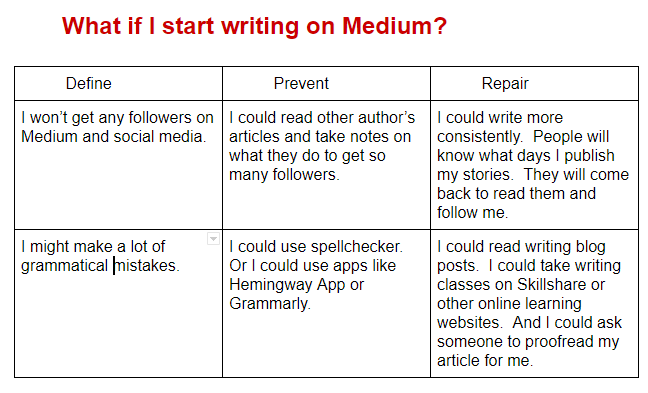All of us have reasons to give up on our goals. Your fear of failure bears down on you. You don’t want to feel the same pain you felt when you had to close your business or when you failed a class. Your challenges make you feel powerless. You feel like there is a huge boulder in your way and you don’t see a way around it.
I have a friend who once told me that she wanted to be a teacher but didn’t think she could because she was physically disabled and couldn’t reach the chalkboard. There are more reasons that people give up on their dreams besides fear of failure. And that is why I wanted to include every barrier you may have to your passions. These ideas will give you comfort, encouragement, and power so that you can face your obstacles and strive for what you want for your life.
Make your passion your home
You’ve tried to accomplish your goals before. But when you failed the first time, you felt defeated and discouraged. So you decided to give up on that dream. You may have decided to focus on another dream that you thought would be successful. Or you gave up on all your dreams convinced that you weren’t talented enough.
Years before the success of her bestselling memoir Eat, Pray, Love Elizabeth Gilbert faced countless rejection from publishers. In her TED Talk Success, Failure, And The Drive To Keep Creating, she says that even though those rejections were devastating she always went back home to writing.
She says, “For me, going home meant returning to the work of writing because writing was my home, because I loved writing more than I hated failing at writing, which is to say that I loved writing more than I loved my own ego, which is ultimately to say that I loved writing more than I loved myself. And that’s how I pushed through it.”
Don’t let your failure be the only memory you have of your dream. Make your dream into a home and keep coming back to it even if it’s just for you. If you’re a writer, write in a journal or write short stories. If you are a cook, try new recipes out for your friends and family. This idea isn’t just for people with creative passions. Everyone can benefit from it.
Try new ideas and learn new things. If your home is your passion it will give you comfort even if you’re not successful right away. And trying new things will encourage you and give you confidence to go after your goals again.
“The only trick is that you’ve got to identify the best, worthiest thing that you love most, and then build your house right on top of it and don’t budge from it.” Elizabeth says, “And if you should someday, somehow get vaulted out of your home by either great failure or great success, then your job is to fight your way back to that home the only way that it has ever been done, by putting your head down and performing with diligence and devotion and respect and reverence whatever the task is that love is calling forth from you next. You just do that, and keep doing that again and again and again, and I can absolutely promise you, from long personal experience in every direction, I can assure you that it’s all going to be okay.”
Define Your Fears Instead Of Your Goals
In Why You Should Define Your Fears Instead Of Your Goals, Tim Ferriss walks us through his easy 3 page fear-setting exercise that helped him overcome his fears.
At the top of the first page you write “What If…?” Write what goal you hope to accomplish here. You could write “What if I go back to college to earn my bachelor’s degree?”, or “What if I start my own marketing company?” Write whatever it is that you hope for.
Then you create 3 columns; Define, Prevent, and Repair.
In the Define column, you list all your fears that are stopping you from going after your dreams.
In the Prevent column, you write down what steps you would take to prevent it from happening or reduce the likelihood.
The Repair column is where you list how you would fix those problems or who to ask for help.
This is the first page of my “Fear-Setting” exercise. I wrote it on Google Docs, but you can write it down on a piece of paper if it’s easier for you. Tim recommends that we write 10 to 20 fears. That might be overwhelming, so I think you should write what you are comfortable with.

For the second page write down what you will gain when you try and what you might gain from partial success. Tim recommends writing for 10 to 15 minutes. You can write them down as a list or in paragraph form.
Write down the benefits of trying and the benefits of partial success together. This will show you that there are just as many benefits for trying as there are for success. With success comes more money and opportunities. But with trying comes confidence, pride, and belief in yourself to name a few.
The third and final page is called “The Cost Of Inaction”. Tim says that this is the most important page, and I agree. He says, “ Humans are very good at considering what might go wrong if we try something new, say, ask for a raise. What we don’t often consider is the atrocious cost of the status quo — not changing anything. So you should ask yourself, “if I avoid this action or decision and actions and decisions like it,what might my life look like in, say, six months, 12 months, three years?”
You may have passed up opportunities or dreams before because of your fears. This time when an opportunity strikes, take the plunge. There is more to gain by following your passions than money and success. Even if you fail you will learn new things, make new friendships, and have amazing experiences that will stay with you for the rest of your life. The most important thing to remember is to grow.

Change How You See Yourself And What You Can Do
What are the reasons you’re giving up on your dreams? Is it a fear of failure, you’re surrounded by negative people, you have a disability, or you have other challenges? No matter what internal or external challenges are in your way, you can create opportunities for yourself. All you need to do is change the way you see yourself.
When I first thought about writing on Medium, I read every article I could find on writing and blogging. That is when I heard about Jon Morrow. He is a successful blogger and founder of Smartblogger.com and Unstoppable.me. His story is inspiring to me because he didn’t get discouraged by his disability and give up. He created his own path to success.
He writes about this in his blog post How To Accomplish Big Things, Even When You Feel Small. “For several years leading up to starting my own business, I ruthlessly eliminated anything that even suggested I was powerless and replaced it with concrete proof that I wasn’t. In other words, I deliberately “brainwashed” myself into believing I could do the impossible.” he says.
There are 3 actions he took:
He listened to audiobooks and podcasts for 4 to 8 hours a day. He wanted to drown out negative thoughts with encouraging stories.
He joined a real estate club and asked the top investors questions.
He went to the library every day until he read all their books. Then he went to Barnes & Noble every day and read those.
Jon has spinal muscular atrophy. He can only move his face, so he uses a lip operated mouse and speech recognition software to write his posts and run his blog. I was born legally blind, and his story inspires me to believe that I can do anything.
If you follow these steps you will start to feel more powerful and victorious over your fears and your challenges. If you don’t have enough experience in your field you can volunteer at a company and learn new skills from experts. You can help a non-profit with everything from cooking to social media marketing. Read blog posts, books, and listen to podcasts outside your field to get ideas. And remember there is nothing you can’t do, especially if you believe in yourself.
“You can’t think your way out of a crappy life. The only way out is to construct a world where incredible things aren’t impossible; they are expected, even commonplace.” Jon says, “Then you must live in that world, spending more time there than you do in the current one.”
Forget About The Traumatic Scenes That Are Holding You Back And Focus On Your Purpose
Throughout our lives there are both happy and traumatic scenes that we hold on to. We continuously replay the traumatic scenes in our minds trying to think of what we could have said or done to change the situation. If you have a fear of failure, you replay the scene when you packed up your office and closed the doors for the last time. This is called ruminating.
I know how damaging ruminating can be. All my life there have been a few people who have tried to control or take advantage of me. I have spent days thinking about the traumatic scene that happened. I’d think about what I should have said to stand up for myself.
But one day I realized that no matter what I said, it wouldn’t have changed the situation. So, I decided to spend only one day thinking about it. After that I let it go. I let it go because I didn’t want those people or the ruminating thought to steal my happiness. And I didn’t want it to stop me from trying to accomplish my goals.
Ruminating can rob more from you than your time. According to Dr. Guy Winch, “Now, ruminating about upsetting events in this way can easily become a habit, and it’s a very costly one, because by spending so much time focused on upsetting and negative thoughts, you are actually putting yourself at significant risk for developing clinical depression, alcoholism, eating disorders, and even cardiovascular disease.”
Thinking of your passion as your purpose in life is a great distraction from these thoughts. Purpose gives you more than something to live for. You feel alive and happy with the life you have created. Your life has meaning because you are helping others. Best of all it changes your life story.
I hope that these ideas have given you encouragement to seek what you dream of. I know that it’s really hard to face your fears and your challenges. But if you take small steps to fight for your goals you will one day fulfill your dreams.
If you liked this article or if it helped you, you can also follow me on Pinterest and Instagram.
Originally published at medium.com


